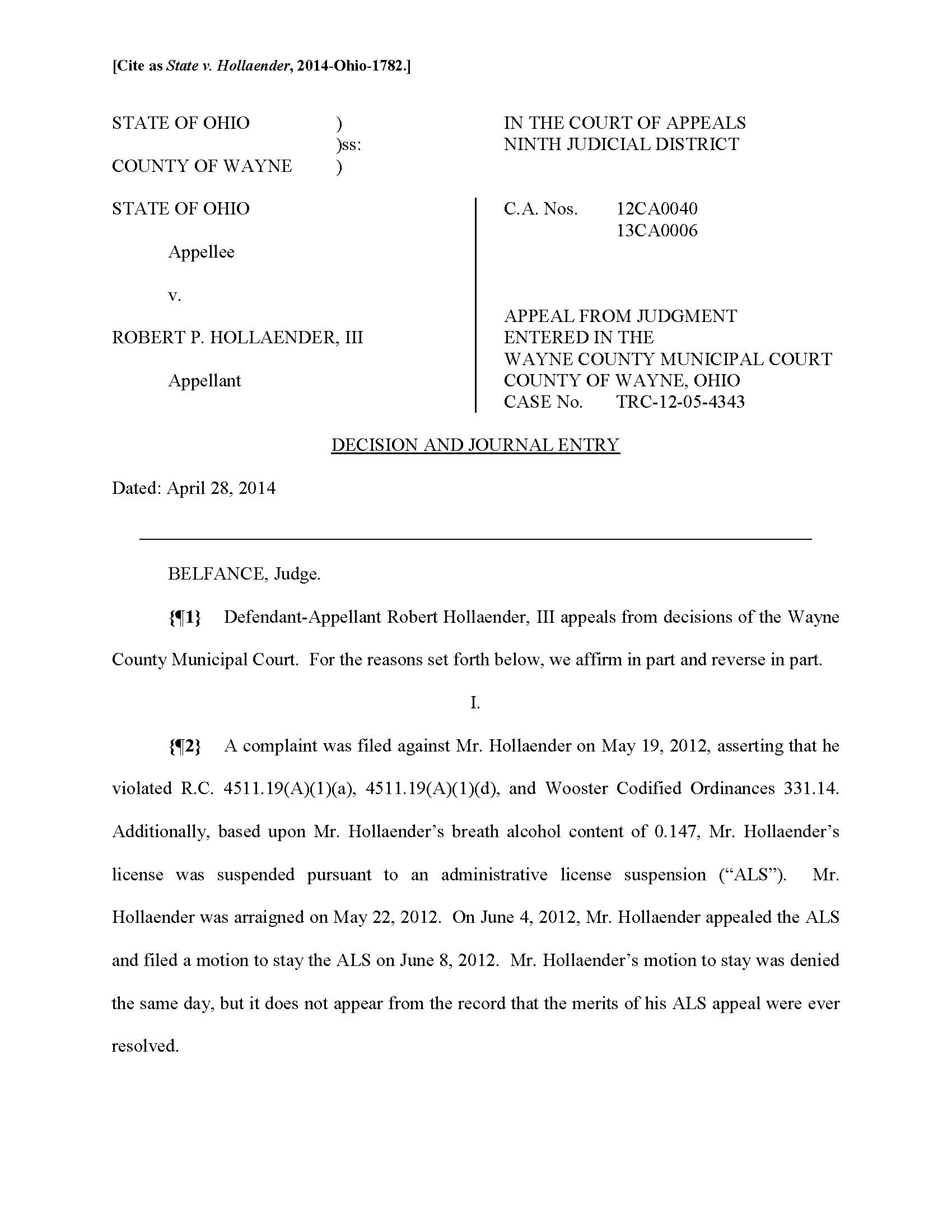 In Ohio DUI/OVI cases, calculating speedy trial time can be complex. As a general rule, the trial must be held within 90 days of the arrest or summons. There are, however, many exceptions to this general rule. When one of the exceptions occurs, time is “tolled” (that time does not count toward the 90-day limit). One exception occurs when the defendant files a motion for discovery, and another exception occurs when the defendant files a motion to suppress evidence. A recent decision by an Ohio Court of Appeals addresses the application of speedy trial laws to Ohio DUI/OVI cases.
In Ohio DUI/OVI cases, calculating speedy trial time can be complex. As a general rule, the trial must be held within 90 days of the arrest or summons. There are, however, many exceptions to this general rule. When one of the exceptions occurs, time is “tolled” (that time does not count toward the 90-day limit). One exception occurs when the defendant files a motion for discovery, and another exception occurs when the defendant files a motion to suppress evidence. A recent decision by an Ohio Court of Appeals addresses the application of speedy trial laws to Ohio DUI/OVI cases.
State v. Hollaender was decided a few days ago. On May 19, 2012, Hollaender was charged with OVI in the Wayne County Municipal Court. At the same time, he was subjected to a 90-day Administrative License Suspension because his breath test result was over .080. On June 29, 2012, Hollaender filed a petition for limited driving privileges. On July 2, 2012, the court denied the petition, and Holleander appealed that denial to the court of appeals. Meanwhile, Holleander had filed a motion to suppress evidence on June 19, 2012. The court scheduled a hearing on the motion to suppress for July 23, 2012, and the motion hearing was continued (at Holleander’s request) to July 30, 2012.
When the time for the motion hearing arrived, the trial court declined to hold the hearing, claiming it did not have jurisdiction to hold the hearing because Holleander appealed the denial of driving privileges. In December of 2012, the appeals court dismissed the appeal regarding driving privileges. On January 23, 2013, the trial court held a hearing on the motion to suppress, as well as Holleander’s recently-filed motion to dismiss the case on speedy trial grounds. On January 24, 2013, the court overruled the motion to suppress and the speedy trial motion. On January 30, 2013, Holleander plead No Contest and appealed to the Ninth District Court of Appeals.
The Court of Appeals conducted a thorough analysis of the speedy trial issue. The court observed that Ohio law requires the trial to start within 90 days after the arrest on May 19, 2012 (R.C. 2945.71). Holleander filed his motion to dismiss for speedy trial violation on January 23, 2013: approximately 250 days after his arrest. Some of that time, however, did not count toward the 90-day time limit because Holleander filed a motion for discovery and a motion to suppress (R.C. 2945.72). Calculating the “tolled” time regarding the motion for discovery was easy: it took one day for the prosecution to provide discovery.
Calculating the “tolled” time regarding the motion to suppress was not so easy. The court ruled on that motion 220 days after it was filed. The prosecution claimed the 220 days to rule on the motion to suppress was reasonable because Holleander had meanwhile appealed the driving privileges denial to the Court of Appeals. The Court of Appeals disagreed, reasoning that Holleander’s appeal of the driving privileges denial did not affect the speedy trial calculation because issues related to the Administrative License Suspension are civil in nature and are separate from the OVI case. The Court of Appeals commented, “Accordingly, we cannot say that it was reasonable for the trial court to fail to conduct the suppression hearing on July 30, 2012. The delay attributable to the trial court’s misunderstanding of the law cannot be attributed to Mr. Holleander.”
As the driving privileges appeal did not affect the speedy trial calculation, the Court of Appeals had to determine how much time was “tolled” by the motion to suppress. The Court of Appeals noted that Rule 40 of the Ohio Rules of Superintendence requires judges to rule upon motions within 180 days. As the motion to suppress was filed on June 19, 2012, it should have been ruled on by October 18, 2012. The trial court did not rule on the motion until January 24, 2013.
From the day of the arrest (5-19-12) to the day the motion was ruled on (1-24-13) was about 250 days. Subtracting one day for the discovery motion and 120 days for the motion to suppress leaves about 129 days that count toward the speedy trial limit of 90 days. As the Court of Appeals stated, “Therefore, it is clear that well over 90 days passed for purposes of speedy trial, and Mr. Holleander was entitled to have his motion to dismiss granted.” Holleander’s case was dismissed.
This case illustrates the complex speedy trial calculations in Ohio DUI/OVI cases. It also highlights the importance of being represented by an effective DUI/OVI lawyer. Holleander’s lawyer did an outstanding job of zealously representing his client.
 Columbus OVI/DUI Attorney Blog
Columbus OVI/DUI Attorney Blog

